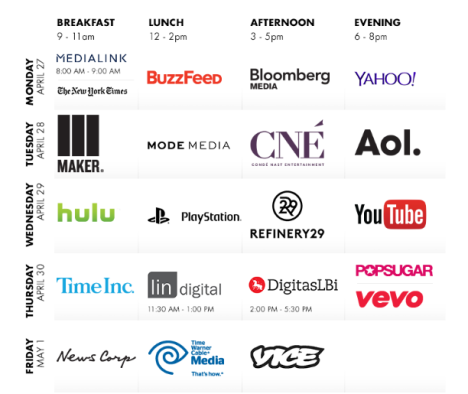Are Aussie publishers prepared for the invasion of the global hordes?
 Last week some of the biggest digital players in the world presented their content and monetisation strategies to advertisers in New York. Nic Christensen sat through many of those Newfront presentations and fears many local media players aren’t ready to compete in the global race for scale and audience.
Last week some of the biggest digital players in the world presented their content and monetisation strategies to advertisers in New York. Nic Christensen sat through many of those Newfront presentations and fears many local media players aren’t ready to compete in the global race for scale and audience.
If I was to distill the most pertinent question for the Australian market from the dozen or so presentations I sat through last week at the IAB Digital Newfronts in New York it would be this: are our local publishers able and willing to “lean in” to video and embrace it as a core part of their future businesses?
If they aren’t preparing a clear and scalable digital strategy with a focus on local premium content they could soon find their lunch being eaten by global players like AOL/Huffpo, Buzzfeed, Daily Mail/Elite Daily, Vice, Vevo, Yahoo and most significantly YouTube.
Rest assured if they aren’t already here (and most are) all of these global players are coming down under and angling for a slice of the Australian ad market.
Sadly I fear for many of the local traditional players (read the likes of Bauer, Fairfax and News Corp plus the TV and radio industries) the answer to this first question about “leaning in” (to use an Americanism) is only a reluctant yes and in the case of the latter question – possibly for many publishers the answer is either no or not without help from a global parent or partnership.
But before I get to why I think that let me take a step back and talk about why the IAB Digital Newsfronts matter.
Taking their lead from TV’s upfronts the Newfronts are a two week event giving companies with a large digital component from a variety of background – from the New York Times to Buzzfeed, and AOL to Vevo – a chance to present their strategies for the year to media buyers and advertisers.
Unlike the TV upfronts though these presentations have a real resonance around the world – after all what goes online now spreads like wildfire to all parts. Many of these are global players with presences in multiple markets – so what we’ve covered over the last few days are solutions we’ll likely see in Australia in some form or other in the coming months.
Like any global media marketing event there’s an element of buzzword bingo – branded content, mobile, premium content, SVOD, virtual reality, social media and programmatic marketing are (if the speakers are to believed) all central pillars to the future of media.
But that’s not to say the events themselves are not important if only to see how global media (regardless of the traditional medium they come from) are trying the grapple with the business model and forge a sustainable future.
Coming from an Australian context I found it fascinating to sit through the hour long New York Times presentation and not hear them mention the word “print” once.
Later when I challenged NYT global CEO Mark Thompson on why that was, he looked almost bemused noting: “We have low single figure million print readers and we have 85m-90m digital readers, over half of which are consuming on mobile, and those digital users are increasingly expanding into video.”
A good example of a global player is the Huffington Post, which had Arianna Huffington lecturing the media about its ‘bleeds its leads’ mentality. While many might be critical of their positive news/aggregator model it clearly works very well making them a global force which will soon be here under the editorship of News Corp Australia’s Tory Maguire.
Similar things can be said about Buzzfeed and its cat memes/branded content social business model. It is truly fascinating that News Corp appears set to mimic them with a “buzzworthy” project called the Internet Action Force.
What worries me is that many local Australian players don’t fully comprehend the size of the threat, or that Australia’s market of 23 million people is actually comparatively small and insignificant in the game of global scale that all of these companies are playing.
Australia’s radio industry body Commercial Radio Australia can talk about how music streaming isn’t radio (presuming listeners care how their music is delivered) but when Vevo stands up and talks about how it has 11 billion – yes billion – music videos plays per month globally this logically has to be having some impact on radio audience numbers in Australia.
Similarly the TV sales bosses might be willing to insist that SVOD will only ever be a “niggle” on their local audiences but when you have the likes Yahoo, AOL, the New York Times and Hulu all wanting a piece of TV’s ad revenues in whatever form, you start to worry that “niggle” in some form might be underestimated, especially when you are talking about a global premium video market.
And that is before you factor in online behemoth Google, who celebrated YouTube’s tenth birthday by filling the theatre at Madison Square Garden with 2,400 people, boasting how in the coveted 18-49 demographic, on mobile alone, they now had more audience than any American cable TV network through broadcast channels.
As one US media buyer told me: “For the last couple of years we’ve heard the digital companies out, and then largely continued to invest our budget as we always did. But this year the online audience numbers mean people are starting to take notice.”
In Australia publishers are all to different extents taking note of digital and in particular video. Fairfax has also led the charge on video journalism, it’s not that long ago since News Corp spent $3m on a new video studio and Bauer recently split off its digital division in an attempt to grow revenue.
Really the question is is this too little too late? And are local operations able to gain the scale they need to compete with these global giants?
In many cases there are parent companies (take News Corp or Bauer) that the publishers can rely on, and perhaps TV and radio can also look for global partnerships, but all of this requires an acknowledgement of where the structural trend is going.
Currently there are too many of our traditional players hiding their heads in the sand and not wanting to acknowledge publicly the challenges they are facing.
Whether it’s print, which has at least started to address the issue with its EMMA metric (although its “outlier” results leave a lot more questions than answers currently), radio and its refusal to acknowledge audio streaming and television’s recent statements about SVOD not being part of TV measurement (despite clearly taking up a growing amount of time spent) all of these media are failing to give media buyers what they want which is reliable, straightforward and accurate information on audience.
At a time when powerful digital enemies are advancing for the local front door, it seems like a dangerous, dare I say it foolhardy, strategy.
Nic Christensen is the deputy editor of Mumbrella and is currently in New York
Declaration: Vevo’s Australian partner Authentic Entertainment sponsored Mumbrella’s coverage of Newfronts.






Global hoardes? Are those maybe hordes? Or possibly whoreds.
User ID not verified.
Hi Tony,
Absolutely right – updated that now.
Cheers,
Alex – editor, Mumbrella
Nice update.
Local publishers are going to get rolled, just like they have in every other digitally disrupted industry.
For some reason, many Australian companies think their man-in-middle looting strategy still flies in the 21st century. No idea why. Customers can now link directly with producers across nearly every industry, including publishing, and they don’t need some import based arse telling them how to consume and at what price.
But the politics of self interest will have a bunch of folks convinced their industry is immune, even though their industry is really just based on bringing some other industry on shore.
The pain is just beginning.
User ID not verified.
Alex,
http://www.thedailymash.co.uk/.....3082378916
User ID not verified.
Local publishers are going to get rolled x2, agree with Jen. No Australian publishers can act like they really tried.
User ID not verified.
This invasion is visible for all to see through these 17 ‘MediaScapes’ which continue to map each channel in the Australian commercial media landscape – http://www.mediascope.com.au/m.....try-guides
User ID not verified.
Good article Nic.
The local “boys” are going to get smashed.
Perhaps with enough Globals playing in our pond, the competition will also do away with the “Australia tax” – perhaps one sliver of upside will be true equitable access to global content? Let’s see.
User ID not verified.
I’m with Jen too.
I’m going direct to the dairy farmer and I can get my milk for 95c a litre instead of being gouged a dollar at the big stores.
User ID not verified.
Milk can’t be digitised. All content can.
User ID not verified.
Holy shit Jen! That’s buggered up my plan. Thanks for pointing that out.
User ID not verified.
I sure hope the ‘tax-effective’ revenue shifting strategies used by global/US tech/media companies are addressed before this happens. Will be a bit sad to watch more of our ad $ flow out the door to Ireland, Delaware and the Cayman Islands.
May the best content win!
User ID not verified.
Nice write up Nic! What will be great is to see the ad buyers recognising the global news sites don’t need to sit in the “international or “US ” site budget box and that Australian users don’t see them as that.. they just want to ( and do in large and competitive numbers) consume and engage with their intelligent content.
User ID not verified.